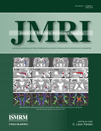Spiral imaging artifact reduction: A comparison of two k-trajectory measurement methods
Abstract
Purpose
To compare an external sensor-based k-space calibration technique with a routine precalibration method for quantification of method accuracy and reduction of spiral imaging artifacts to obtain improved image quality.
Materials and Methods
Recently, magnetic field monitoring (MFM) has been introduced as a new calibration technique of gradient field-related imperfections. External sensors are placed near the observed object to measure magnetic field variations during image acquisition. The measured field data are used to determine the actual k-space trajectory and for image reconstruction to reduce artifacts. In the past, precalibration techniques have been proposed where the k-space trajectory is measured by means of special calibration sequences directly in the object of interest. In this study, MFM is introduced as an effective correction technique for spiral imaging. On the basis of a comparison, whether MFM is as viable as the chosen reference method presented by Duyn et al (J Magn Reson [1998] 132:150–153) is analyzed in terms of detecting imperfections of spatial encoding gradients in order to correct for these in image reconstruction. As this technique is used as a reference method, it is given the acronym Duyn calibration technique (DCT). MFM and DCT are compared and timing delays, k-space offsets, eddy current effects, k-trajectory error propagation, image distortions, and signal-to-noise ratio were determined for different spiral sequences in two different phantoms.
Results
Both techniques effectively detect k-space offsets and k-trajectory error propagation and correct for general error sources like timing delays. In object border areas, artifacts such as deformations and blurring were dramatically reduced. Within all tested categories, MFM performed as well as DCT. In terms of k-trajectory error propagation and image distortion quantification, MFM was more accurate.
Conclusion
We introduce MFM as an effective and accurate correction technique for spiral imaging, where a comparison of MFM and DCT has shown that both techniques are accurate correction techniques for spiral imaging. J. Magn. Reson. Imaging 2009;29:1485–1492. © 2009 Wiley-Liss, Inc.




